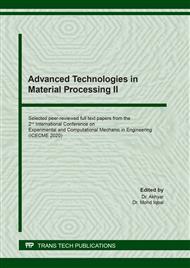[1]
Abraham, N., James, J., Banerji, T. & Menon, R. Development of a novel groundwater iron removal system using adsorptive Fe(II) process. Groundw. Sustain. Dev. 10, 100318 (2020).
DOI: 10.1016/j.gsd.2019.100318
Google Scholar
[2]
Chakraborti, D., Das, B. & Murrill, M. T. Examining India's groundwater quality management. Environ. Sci. Technol. 45, 27–33 (2011).
DOI: 10.1021/es101695d
Google Scholar
[3]
Khurana, I. & Sen, R. Drinking water quality in rural India : Issues and approaches. Water aid. 31 (2008).
Google Scholar
[4]
USEPA. Quality Criteria for Water 1986. Water. 477 (1986).
Google Scholar
[5]
Indonesia, T. P. of T. R. of. Management of water quality and control over water pollution. 20–29 (2001).
Google Scholar
[6]
Gao, C., Wang, A., Wu, W. M., Yin, Y. & Zhao, Y. G. Enrichment of anodic biofilm inoculated with anaerobic or aerobic sludge in single chambered air-cathode microbial fuel cells. Bioresour. Technol. 167, 124–132 (2014).
DOI: 10.1016/j.biortech.2014.05.120
Google Scholar
[7]
Pandey, S. A comprehensive review on recent developments in bentonite-based materials used as adsorbents for wastewater treatment. J. Mol. Liq. 241, 1091–1113 (2017).
DOI: 10.1016/j.molliq.2017.06.115
Google Scholar
[8]
Jiang, L., Ye, Q., Chen, J., Chen, Z. & Gu, Y. Preparation of magnetically recoverable bentonite–Fe3O4–MnO2composite particles for Cd(II) removal from aqueous solutions. J. Colloid Interface Sci. 513, 748–759 (2018).
DOI: 10.1016/j.jcis.2017.11.063
Google Scholar
[9]
Ahrouch, M., Gatica, J. M., Draoui, K. & Vidal, H. Adding value to natural clays as low-cost adsorbents of methylene blue in polluted water through honeycomb monoliths manufacture. SN Appl. Sci. 1, (2019).
DOI: 10.1007/s42452-019-1636-4
Google Scholar
[10]
Salem Attia, T. M., Hu, X. L. & Yin, D. Q. Synthesized magnetic nanoparticles coated zeolite for the adsorption of pharmaceutical compounds from aqueous solution using batch and column studies. Chemosphere 93, 2076–2085 (2013).
DOI: 10.1016/j.chemosphere.2013.07.046
Google Scholar
[11]
Mohammed, A. A. & Samaka, I. S. Bentonite coated with magnetite Fe3O4 nanoparticles as a novel adsorbent for copper (II) ions removal from water/wastewater. Environ. Technol. Innov. 10, 162–174 (2018).
DOI: 10.1016/j.eti.2018.02.005
Google Scholar
[12]
Zhang, H. et al. Nano γ-Fe2O3/bentonite magnetic composites: Synthesis, characterization and application as adsorbents. J. Alloys Compd. 688, 1019–1027 (2016).
DOI: 10.1016/j.jallcom.2016.07.036
Google Scholar
[13]
Delgado, N., Capparelli, A., Navarro, A. & Marino, D. Pharmaceutical emerging pollutants removal from water using powdered activated carbon: Study of kinetics and adsorption equilibrium. J. Environ. Manage. 236, 301–308 (2019).
DOI: 10.1016/j.jenvman.2019.01.116
Google Scholar
[14]
Martini, B. K., Daniel, T. G., Corazza, M. Z. & De Carvalho, A. E. Methyl orange and tartrazine yellow adsorption on activated carbon prepared from boiler residue: Kinetics, isotherms, thermodynamics studies and material characterization. J. Environ. Chem. Eng. 6, 6669–6679 (2018).
DOI: 10.1016/j.jece.2018.10.013
Google Scholar
[15]
Wijaya, K., Tahir, I. & Baikuni, A. The synthesis of cr2o3-pillared montmorillonite (crpm) and its usage for host material of p-nitroaniline. Indones. J. Chem. 2, 12–21 (2010).
DOI: 10.22146/ijc.21928
Google Scholar
[16]
Karri, R. R., Sahu, J. N. & Jayakumar, N. S. Optimal isotherm parameters for phenol adsorption from aqueous solutions onto coconut shell based activated carbon: Error analysis of linear and non-linear methods. J. Taiwan Inst. Chem. Eng. 80, 472–487 (2017).
DOI: 10.1016/j.jtice.2017.08.004
Google Scholar
[17]
Ren, S. et al. Comparison of Cd2+ adsorption onto amphoteric, amphoteric-cationic and amphoteric-anionic modified magnetic bentonites. Chemosphere 239, 124840 (2020).
DOI: 10.1016/j.chemosphere.2019.124840
Google Scholar
[18]
Zhang, H. et al. Fabrication of magnetic bentonite/carboxymethyl chitosan/sodium alginate hydrogel beads for Cu (II) adsorption. Int. J. Biol. Macromol. 135, 490–500 (2019).
DOI: 10.1016/j.ijbiomac.2019.05.185
Google Scholar
[19]
Wang, K. et al. Hybrid porous magnetic bentonite-chitosan beads for selective removal of radioactive cesium in water. J. Hazard. Mater. 362, 160–169 (2019).
DOI: 10.1016/j.jhazmat.2018.08.067
Google Scholar
[20]
Choong, T., Yunus, R. & Yap, Y. Adsorption of Methylene Blue from Aqueous Solutions on Carbon Coated Monolith. ASEAN J. 8, 27–38 (2008).
Google Scholar
[21]
Tran, H. N., You, S. J., Hosseini-Bandegharaei, A. & Chao, H. P. Mistakes and inconsistencies regarding adsorption of contaminants from aqueous solutions: A critical review. Water Res. 120, 88–116 (2017).
DOI: 10.1016/j.watres.2017.04.014
Google Scholar


